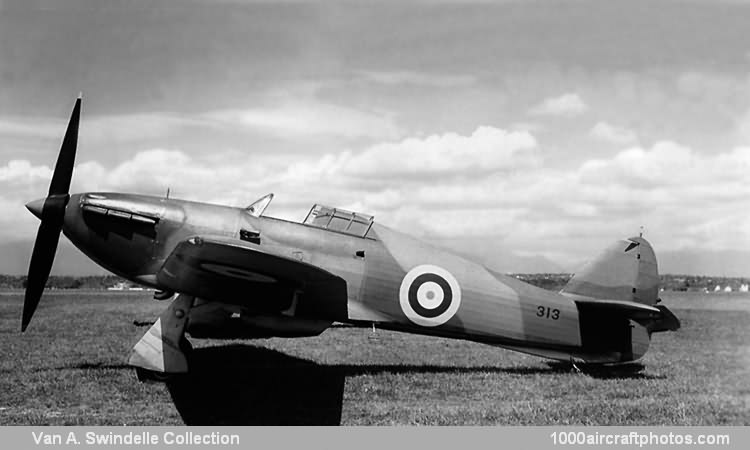08/31/2011. Remarks by Johan Visschedijk: "The first fighter of monoplane configuration to enter service with the RAF, the Hurricane, designed by Sydney Camm at Hawker Aircraft Ltd., Kingston upon Thames, Surrey, was initiated as a private venture. Around the detail design of this fighter Specification F.36/34 was eventually written. Utilizing Hawker's well-established structural principles, the fighter was of rigidly-braced steel and light alloy tubing construction with fabric skinning, a prototype being flown on November 6, 1935.
A contract for 600 Hurricanes was placed on July 20, 1936, the first production example flying on October 12 1937 with a Rolls-Royce Merlin II engine rated at 1,030 hp at 16,250 ft (4,955 m). This drove a fixed-pitch two-bladed propeller with which a max speed of 318 mph (512 kmh) was attained at 17,400 ft (5,305 m).
Flight testing with the similarly-rated Merlin III and a constant-speed three-bladed propeller began on January 24, 1939, this combination eventually being standardized for the Hurricane Mk.I which carried an armament of eight 0.303 in (7.7 mm) wing-mounted Browning machine guns. Metal stressed-skin was adopted in place of fabric for the wings, aircraft embodying this change being delivered to the RAF from September 29, 1939.
Hawker produced 1,924 Hurricane Mk.Is, and Gloster 1,850, other than to the RAF itself, these were delivered to the governments of Belgium (15), Canada (22), Finland (12), Persia (1), Poland (1), Romania (12), Turkey (15), and Yugoslavia (24) to during 1939-1940. In addition, Hurricane Mk.Is were produced under license by Canadian Car and Foundry (CCF) (116), Zmaj of Yugoslavia (20) and Avions Fairey of Belgium (3), bringing the total Hurricane Mk.Is produced to 3913.
Bill Walker adds: "Formerly RAF L1762, this aircraft was one of 600 ordered under Air Ministry Contract No. 527112/36 of June 3, 1936. It was produced under Hawker Works Order 3054 (for a batch of 50 aircraft, RAF s/n L1748 to L1797) under s/n L1762, but under Works Order 6243, it was shipped to Vancouver, British Columbia, Canada, and became one of the 20 aircraft delivered to the RCAF (s/n 310 to 329).
It arrived with a Watts wooden two-blade fixed-pitch propeller and was taken on charge with s/n 313 on March 2, 1939. It was used for training by A Flight, No. 1 (F) Squadron at Vancouver Airport, which later was renamed RCAF Station Sea Island, and where probably the photo was taken, looking north towards The Lions mountain range north of Vancouver.
When No. 1 (F) Squadron went to the UK in early 1940, they took 10 of these Hurricanes with them, including 313, which was coded 'YO-L' at that time. It later passed back to the RAF, but retained the RCAF three-digit serial. It was operated by No. 6 (later No. 56) OTU, RAF, in late 1940 - early 1941, and it became an instructional airframe in 1943."
